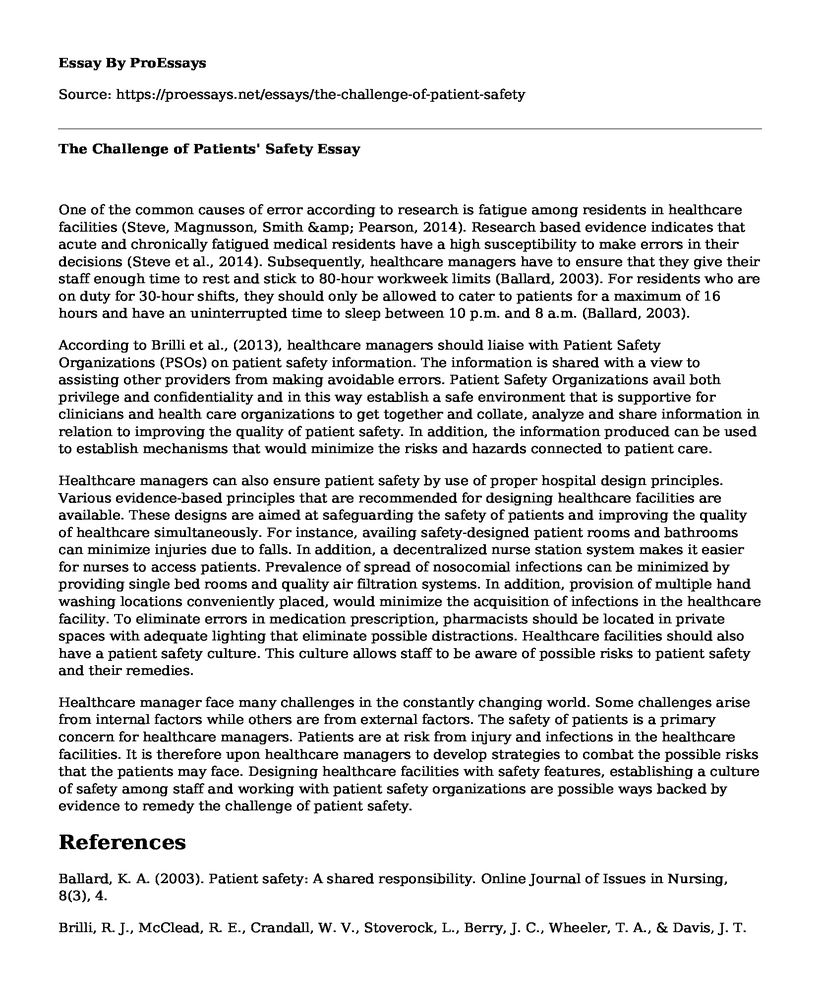One of the common causes of error according to research is fatigue among residents in healthcare facilities (Steve, Magnusson, Smith & Pearson, 2014). Research based evidence indicates that acute and chronically fatigued medical residents have a high susceptibility to make errors in their decisions (Steve et al., 2014). Subsequently, healthcare managers have to ensure that they give their staff enough time to rest and stick to 80-hour workweek limits (Ballard, 2003). For residents who are on duty for 30-hour shifts, they should only be allowed to cater to patients for a maximum of 16 hours and have an uninterrupted time to sleep between 10 p.m. and 8 a.m. (Ballard, 2003).
According to Brilli et al., (2013), healthcare managers should liaise with Patient Safety Organizations (PSOs) on patient safety information. The information is shared with a view to assisting other providers from making avoidable errors. Patient Safety Organizations avail both privilege and confidentiality and in this way establish a safe environment that is supportive for clinicians and health care organizations to get together and collate, analyze and share information in relation to improving the quality of patient safety. In addition, the information produced can be used to establish mechanisms that would minimize the risks and hazards connected to patient care.
Healthcare managers can also ensure patient safety by use of proper hospital design principles. Various evidence-based principles that are recommended for designing healthcare facilities are available. These designs are aimed at safeguarding the safety of patients and improving the quality of healthcare simultaneously. For instance, availing safety-designed patient rooms and bathrooms can minimize injuries due to falls. In addition, a decentralized nurse station system makes it easier for nurses to access patients. Prevalence of spread of nosocomial infections can be minimized by providing single bed rooms and quality air filtration systems. In addition, provision of multiple hand washing locations conveniently placed, would minimize the acquisition of infections in the healthcare facility. To eliminate errors in medication prescription, pharmacists should be located in private spaces with adequate lighting that eliminate possible distractions. Healthcare facilities should also have a patient safety culture. This culture allows staff to be aware of possible risks to patient safety and their remedies.
Healthcare manager face many challenges in the constantly changing world. Some challenges arise from internal factors while others are from external factors. The safety of patients is a primary concern for healthcare managers. Patients are at risk from injury and infections in the healthcare facilities. It is therefore upon healthcare managers to develop strategies to combat the possible risks that the patients may face. Designing healthcare facilities with safety features, establishing a culture of safety among staff and working with patient safety organizations are possible ways backed by evidence to remedy the challenge of patient safety.
References
Ballard, K. A. (2003). Patient safety: A shared responsibility. Online Journal of Issues in Nursing, 8(3), 4.
Brilli, R. J., McClead, R. E., Crandall, W. V., Stoverock, L., Berry, J. C., Wheeler, T. A., & Davis, J. T. (2013). A comprehensive patient safety program can significantly reduce preventable harm, associated costs, and hospital mortality. The Journal of pediatrics, 163(6), 1638-1645.
Henneman, E. A., Gawlinski, A., & Giuliano, K. K. (2012). Surveillance: a strategy for improving patient safety in acute and critical care units. Critical Care Nurse, 32(2), e9-e18.
Steven, A., Magnusson, C., Smith, P., & Pearson, P. H. (2014). Patient safety in nursing education: contexts, tensions and feeling safe to learn.Nurse education today, 34(2), 277-284.
Wachter, R. M., Pronovost, P., & Shekelle, P. (2013). Strategies to improve patient safety: the evidence base matures. Annals of internal medicine,158(5_Part_1), 350-352.
Cite this page
The Challenge of Patients' Safety. (2021, Mar 02). Retrieved from https://proessays.net/essays/the-challenge-of-patient-safety
If you are the original author of this essay and no longer wish to have it published on the ProEssays website, please click below to request its removal:
- Coursework Example: Diet and Activities for an Overweight Patient with Osteoporosis
- Evidence-Based Approaches to Reduce and Prevent CAUTIs among Residents of Nursing Homes and Healthcare Centers
- Description of Cancer in the Context of Normal Physiology of the Cells Essay
- How a Nurse Leader Helps a Nurse Colleague Pursue Their Professional Goals Essay
- Research Paper on Compensation Issues in Nursing and Staff Shortage
- Essay Sample on COVID-19 Puts Brakes on Global Trade, Businesses Struggle
- Managing Long-Term Conditions: Medications & Treatment - Essay Sample







